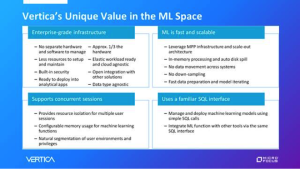On Vertica 10.0 Interview with Mark Lyons
“Supporting arrays, maps and structs allows customer to simplify data pipelines, unify more of their semi-structured data with their data warehouse as well as maintain better real world representation of their data from relationships between entities to customer orders with item level detail. A good example is groups of cell phone towers that are used for one call while driving on the highway.” –Mark Lyons
I have interviewed Mark Lyons, Director of Product Management at Vertica. We talked about the new Vertica 10.0
RVZ
Q1. What is your role at Vertica?
Mark Lyons: My role at Vertica is Director of Product Management. I have a team of 5 product managers covering analytics, security, storage integrations and cloud.
Q2. You recently announced Vertica Version 10. What is special about this release?
Mark Lyons: Vertica 10.0 is a milestone release and special in many ways from Eon Mode improvements to TensorFlow integration for trained models, and the ability to query complex data types like arrays, maps and structs. This release delivers on all aspects of why customers choose Vertica including performance improvements and our constant dedication to keeping our platform in front of the competition from an architecture standpoint.
Q3. Specifically why and how did you improve Vertica in Eon Mode?
Mark Lyons: The Eon Mode improvements are a long list of features including faster elasticity with sub-clusters, stronger workload isolation between sub-clusters and more control over the depot for performance tuning. Also Eon Mode is now available on two new communal storage options Google Cloud Platform and Hadoop Distributed File System (HDFS) in addition to what we already support which is Amazon Web Services S3, Pure Storage Flash Blades and MinIO. From here we are working on adding Azure and Alibaba for public cloud options and expanding our on-prem options with other vendors that our customers have shown interest in like Dell/EMC ECS storage offering and others.
Eon mode is run worldwide by many of our largest customers in production at this point and if you are interested in learning more about the scale and flexibility I recommend looking at our case study with The Trade Desk. They now run 2 Eon Mode clusters both at 320 nodes and petabytes of data growing every day.
Q4. So, one of your key improvement is to support complex types to improve integration with Parquet. How will that benefit businesses?
Mark Lyons: We’ve had high performance query ability on Parquet data whether that is on HDFS or S3 for years including column pruning and predicatepushdown. We continue to invest in our Parquet integration since it is an important part of many organizations’ analytics & data lake strategy. Over the past couple of releases we’ve been building the ability to query complex data types while maintaining columnar execution and late materialization for high performance.
Supporting arrays, maps and structs allows customer to simplify data pipelines, unify more of their semi-structured data with their data warehouse as well as maintain better real world representation of their data from relationships between entities to customer orders with item level detail. A good example is groups of cell phone towers that are used for one call while driving on the highway. We have seen tremendous interest from our customers in this new functionality. We have been actively testing preview builds of Vertica 10 with many customers for querying maps, arrays and structs for some time now.
Q5. How will this new release benefit people using Vertica in Enterprise Mode, people who or aren’t even on the Cloud and have no plans to go to the Cloud?
Mark Lyons: Vertica Enterprise Mode benefits from all of the improvements to the query optimizer, execution engine, machine learning, complex data types and beyond since there is only one Vertica code base and the Eon mode differences are limited to communal storage and sub-clusters. Enterprise Mode is the traditional direct attached storage. Massively Parallel Processing (MPP), shared nothing architectures are still appropriate for many organizations that don’t have plans to move to public cloud and have traditional data center infrastructure. Vertica doesn’t restrict on-premises customers to only using shared storage options like Pure Storage Flash Blades or HDFS. With a Vertica license these customers have the flexibility to deploy where they want in whichever architecture fits today, and they can change in the future without any license cost.
Q6. What are the features you offer in your in-database machine learning in Vertica?
Mark Lyons: Vertica is not normally thought of as a data science platform coming out of the MPP Column Store RDBMS space but we have built functions to make the data science pipeline very easy. We offer functions from data loading a variety of formats, enrichment, preparation and quality functions for data transformation as well as algorithms to train, score and evaluate models. There’s a lot more than I can begin to cover here. To learn more I suggest reading about the Vertica machine learning capabilities here.
In Vertica 10.0 we’ve added the capabilities to import and export PMML models to support data scientist training models in other tools like Python or Spark or use cases where a model trained in Vertica should be pushed to the edge for evaluation in a complex event processing/streaming system. We also added TensorFlow integration to import deep learning models trained on GPUs outside of Vertica into the data warehouse for scoring and evaluation on new customer or device data as it arrives.
Q7. There are several companies offering data platforms for machine learning (e.g. Alteryx Analytics, H2O.ai, RapidMiner, SAS Enterprise Miner (EM), SAS Visual Analytics, Databricks Unified Analytics Platform, IBM SPSS, Microsoft Azure Machine Learning, Teradata Unified Data Architecture, InterSystems IRIS Data Platform). How does Vertica compare to the other data platforms offering machine learning features?
Mark Lyons: The Vertica differentiation compared to these other tools is all about bringing scale, concurrency, performance and operational ML simplicity to the story. All of the data science tools you mention have equivalent functions for data prep, modeling, algorithms etc. and with all of the work we have done the past 3+ years Vertica has much of the same functionality you find in those other tools except for the GUI. For that, many of our customers use Jupyter notebooks.
Vertica performance is achieved by first the MPP architecture and second by in-memory and auto spill to disk so we can handle the largest data sets without being limited by the compute power of a single node or by the memory available like many solutions are. The beauty of this is users do not have to be aware of this or do anything. It just works! In addition to being able to train on trillions of rows and thousands of columns you get enterprise readiness with resource management between jobs, high concurrency to support many users on the same system at the same time, workload isolation to keep ML workloads from overwhelming other analytics areas, security built in with authentication & access policies, and compliance with logging/audit of all ML workflows.
Q8. What are the most successful use cases which use the Machine Learning features offered by Vertica?
Mark Lyons: We are solving all of the most common use cases from fraud detection to churn prevention to cybersecurity threat analytics. Vertica brings a new level of scale and speed to allow for more frequent model re-training, and use of the entire dataset even if that is trillions of rows and PBs of data without data movement or down sampling.
Q9. Anything else you wish to add?
Mark Lyons: A few weeks ago we wrapped up our Vertica Big Data Conference 2020 and I recommend anyone interested in learning more to come and watch replays of the sessions.
———————-
Mark Lyons, Director of Product Management, Vertica
Mark leads the Vertica product management team. His expertise is in new product introductions, go-to-market planning, product roadmaps, requirement development, build/buy/partner analysis, new products, innovation and strategy.
Resources
Virtual Vertica Big Data Conference 2020
Related Posts
Top 10 Highlights from the Virtual Vertica BDC 2020
Follows us on Twitter: @odbmsorg
##



